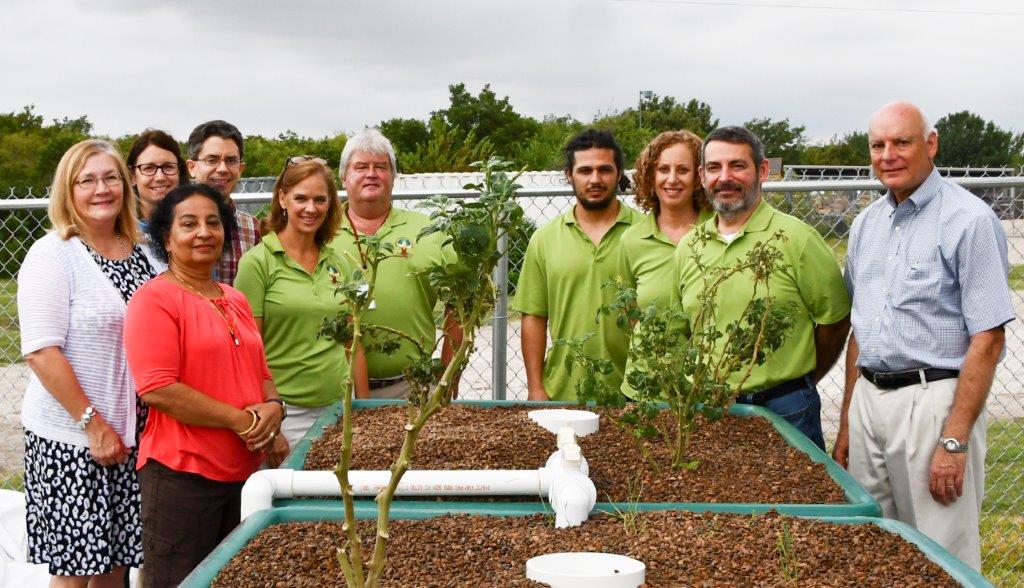Aquaponics – the word sounds intriguing, at least for someone like me, who loves water and taking care of things that grow.
Two years ago, I had never heard this word. I knew a bit about aquaculture (raising fish), which is a 4,000-year-old industry that originated in China.
Hydroponic plant cultivation is something I was also familiar with, which refers to growing plants in water instead of soil. That industry isn’t nearly as old.
The first official book on the subject was not published until the 1620s, but some cite the amazing Hanging Gardens of Babylon as an example of hydroponics. These magnificently engineered gardens were said to have been built during the reign of King Nebuchadnezzar II (606 B.C.E. – 562 B.C.E.), who had them constructed out of mud-brick structures that held pools of water with all types of trees, herbs, shrubs and vines growing in them. Rumor has it that the structure was designed in such a way that it looked like a giant green mountain! Evidence of this garden’s historical existence is still a bit scarce, but we can say with more authority that the Aztecs had floating gardens (Chinampas) in Tenochtitlan as early as the 10th century C.E., which certainly counts as hydroponics.
The popular Medieval traveler, Marco Polo, also mentioned in his book from the early 14th century that people in Asia had “verdant gardens, finely watered by streams.” Interesting stuff!
Both aquaculture and hydroponics have a long history . . . but aquaponics? Well, the term was not actually coined until the 1970s, but it essentially refers to a modern version of what the Aztecs might have inadvertently been doing, or the Chinese in rice patties: combining aquaculture (‘aqua”) with hydroponics (“ponics”). This is truly a masterly combination, because fish waste from aquaculture farming builds up to toxic levels that need to be removed or else the fish will die, which can be hazardous and/or expensive. As for hydroponic cultivation, its major problem is that farmers must add nutrients to their grow water, which can also be extremely expensive and hazardous to the environment if not disposed of properly. Aquaponics remedies both predicaments in a symbiotic way.
Some of you may be wondering, “How does this combination work?” Fish produce waste after they eat. This waste contains ammonia, which then converts into nitrates with the help of beneficial bacteria. Nitrates happen to contain the nutrients that are needed for hydroponic systems to function, which means that plants connected to a fish tank will essentially clean the water by absorbing the waste into their root system as nutrients.
With a few choice materials from a local hardware store, an entire system can be hooked up easily and on a tight budget. Of course, there are also state-of-the-art versions like the one installed on the Southeast Campus. The concept remains the same though, so you can choose the size that best suits your time, space and budget.
From the widest-angled photo, the most recognizable part of Southeast’s new system is the big cylinder tank that holds up to 350 gallons of water. This is the main water reservoir, and it is where the fish hang out all the time. We currently house goldfish, but any number of species can be raised, especially if the aquaponics system is housed indoors. Connected to the bottom of it is PVC pipe that is connected to a pump that sucks the water through a bio-filter. Next to the main tank is a metal stand that has a smaller water tank housed underneath it. This tank also has PVC pipe connected to it, which sucks water into the same bio-filter as the larger tank. After the water passes through the filtration system, it runs through more pipe and sends it in two different directions. One is back into the big tank, where it pours in from a PVC pipe built into a hole near the top. The other pipe sends the filtered water into two grow beds, sitting on top of a metal stand (there are only a few tomato plants in there now, but a whole bunch more can be added).
The grow beds are full of hardened and broken Oklahoma red clay, but there are a variety of different grow mediums that can be used. Other mediums include broken rocks, floating crates of Styrofoam or fish tank pebbles. Basically, it’s the stuff that the plants will be growing in, because water fills up in these grow beds before spilling over into another pipe that sends it back into the tank below. This water is filled with nutrients generated from the fish waste, feeding the plants naturally!
The cycle runs continuously on a 20-amp electrical outlet, which we hope to someday have connected to a solar panel. The whole system needs to run with just fish in it for a few weeks to get the bacteria levels up enough for plants to survive, but after that the whole system pretty much runs itself. Fresh produce of the best quality (and if you have catfish or other species, a source of protein as well)!
-Bradley J. Borougerdi

